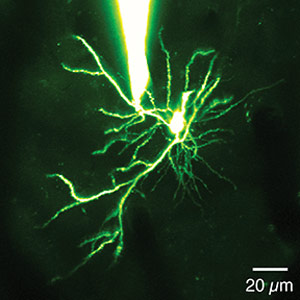
This is a dendrite in a single neuron in the brain. The bright object from the top is a pipette attached to a dendrite in the brain of a mouse. The pipette allows researchers to measure electrical activity, such as a dendritic spike. Credit: UNC Health Care
New research from UNC Health Care and UNC School of Medicine shows that dendrites actively process information, multiplying the brain’s computing power.
Chapel Hill, North Carolina – Dendrites, the branch-like projections of neurons, were once thought to be passive wiring in the brain. But now researchers at the University of North Carolina at Chapel Hill have shown that these dendrites do more than relay information from one neuron to the next. They actively process information, multiplying the brain’s computing power.
“Suddenly, it’s as if the processing power of the brain is much greater than we had originally thought,” said Spencer Smith, PhD, an assistant professor in the UNC School of Medicine.
His team’s findings, published October 27 in the journal Nature, could change the way scientists think about long-standing scientific models of how neural circuitry functions in the brain, while also helping researchers better understand neurological disorders.
Axons are where neurons conventionally generate electrical spikes, but many of the same molecules that support axonal spikes are also present in the dendrites. Previous research using dissected brain tissue had demonstrated that dendrites can use those molecules to generate electrical spikes themselves, but it was unclear whether normal brain activity uses those dendritic spikes. For example, could dendritic spikes be involved in how we see?
The answer, Smith’s team found, is yes. Dendrites effectively act as mini-neural computers, actively processing neuronal input signals themselves.
Directly demonstrating this required a series of intricate experiments that took years and spanned two continents, beginning in senior author Michael Hausser’s lab at University College London, and being completed after Smith and Ikuko Smith, PhD, DVM, set up their own lab at the University of North Carolina. They used patch-clamp electrophysiology to attach a microscopic glass pipette electrode, filled with a physiological solution, to a neuronal dendrite in the brain of a mouse. The idea was to directly “listen” in on the electrical signaling process.
“Attaching the pipette to a dendrite is tremendously technically challenging,” Smith said. “You can’t approach the dendrite from any direction. And you can’t see the dendrite. So you have to do this blind. It’s like fishing but all you can see is the electrical trace of a fish.” And you can’t use bait. “You just go for it and see if you can hit a dendrite,” he said. “Most of the time you can’t.”
But Smith built his own two-photon microscope system to make things easier.
Once the pipette was attached to a dendrite, Smith’s team took electrical recordings from individual dendrites within the brains of anesthetized and awake mice. As the mice viewed visual stimuli on a computer screen, the researchers saw an unusual pattern of electrical signals – bursts of spikes – in the dendrite.
Smith’s team then found that the dendritic spikes occurred selectively, depending on the visual stimulus, indicating that the dendrites processed information about what the animal was seeing.
To provide visual evidence of their finding, Smith’s team filled neurons with calcium dye, which provided an optical readout of spiking. This revealed that dendrites fired spikes while other parts of the neuron did not, meaning that the spikes were the result of local processing within the dendrites.
Study co-author Tiago Branco, PhD, created a biophysical, mathematical model of neurons and found that known mechanisms could support the dendritic spiking recorded electrically, further validating the interpretation of the data.
“All the data pointed to the same conclusion,” Smith said. “The dendrites are not passive integrators of sensory-driven input; they seem to be a computational unit as well.”
His team plans to explore what this newly discovered dendritic role may play in brain circuitry, particularly in conditions like Timothy syndrome, in which the integration of dendritic signals may go awry.
Study co-authors were Ikuko Smith, PhD, DVM, Tiago Branco, PhD, and Michael Häusser, PhD. This work was supported by a Long-Term Fellowship and a Career Development Award from the Human Frontier Science Program, a Klingenstein Fellowship to S. Smith, a Helen Lyng White Fellowship to I. Smith, a Wellcome Trust and Royal Society Fellowship, and Medical Research Council (UK) support to T. Branco, and grants from the Wellcome Trust, the European Research Council, and Gatsby Charitable Foundation to M. Häusser.
Reference: “Dendritic spikes enhance stimulus selectivity in cortical neurons in vivo” by Spencer L. Smith, Ikuko T. Smith, Tiago Branco and Michael Häusser, 27 October 2013, Nature.
DOI: 10.1038/nature12600









Nasty animal testing freaks!